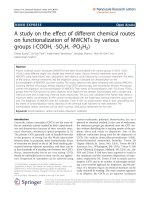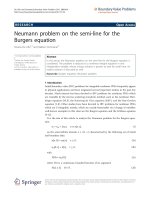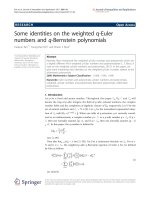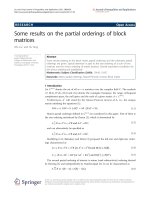Báo cáo hóa học: " Some identities on the weighted q-Euler numbers and q-Bernstein polynomials" pot
Bạn đang xem bản rút gọn của tài liệu. Xem và tải ngay bản đầy đủ của tài liệu tại đây (203.47 KB, 7 trang )
RESEARCH Open Access
Some identities on the weighted q-Euler
numbers and q-Bernstein polynomials
Taekyun Kim
1*
, Young-Hee Kim
1
and Cheon S Ryoo
2
* Correspondence:
1
Division of General Education-
Mathematics, Kwangwoon
University, Seoul 139-701, Korea
Full list of author information is
available at the end of the article
Abstract
Recently, Ryoo introduced the weighted q-Euler numbers and polynomials which are
a slightly different Kim’s weighted q-Euler numbers and polynomials(see C. S. Ryoo, A
note on the weighted q-Euler numbers and polynomials, 2011]). In this pa per, we
give some interesting new identities on the weighted q-Euler numbers related to the
q-Bernstein polynomials
2000 Mathematics Subject Classification - 11B68, 11S40, 11S80
Keywords: Euler numbers and polynomials, q-Euler numbers and polynomials,
weighted, q-Euler numbers and polynomials, Bernstein polynomials, q-Bernstein
polynomials
1. Introduction
Let p be a fixed odd prime number. Throughout t his paper ℤ
p
,
Q
p
, ℂ and ℂ
p
will
denote the r ing of p-adic integers, the field of p-adic rational numbers, the complex
number fields and the compl etion of algebraic closure of
Q
p
, respecti vely. Let N be the
set of natural numbers and ℤ
+
= N ∪ {0}. Let ν
p
be the normalized exponential valua-
tion of ℂ
p
with
|p|
p
= p
−ν
p
(p)
=
1
p
. When one talks of q-extension, q is variously consid-
ered as an indeterminate, a complex number q Î ℂ,orap-adic number q Î ℂ
p
.Ifq Î
ℂ, then one normally assumes |q| <1, and if q Î ℂ
p
, then one normally assumes |q-1|
p
<1. In this paper, the q-number is defined by
[x]
q
=
1 − q
x
1 −
q
,
.
(see [1-19])
Note that lim
q®1
[x]
q
= x (see [1-19]). Let f be a continuous function on ℤ
p
.Fora Î
N and k, n Î ℤ
+
, the weighted p-adic q-Bernstein operator of order n for f is defined
by Kim as follows:
B
(α)
n,q
(f |x)=
n
k=0
n
k
f
k
n
[x]
k
q
α
[1 − x]
n−
k
q
−α
=
n
k
=
0
f
k
n
B
(α)
k,n
(x, q), .
(1)
see [4,9,19].
Kim et al. Journal of Inequalities and Applications 2011, 2011:64
/>© 2011 Kim et al; licensee Sp ringer. This is an Open Access artic le distributed under the terms of the C reative Commons Attr ibution
License ( which permits unrestricted use, distribution, and reproduction in any medium,
provided the original work is properly cited .
Here
B
(α)
k,n
(x, q)=
n
k
[x]
k
q
α
[1 − x]
n−
k
q
−α
are called the q-Bernstein polynomials of
degree n with weighted a.
Let C(ℤ
p
) be the space of continuous functions on ℤ
p
. For f Î C(ℤ
p
), the fermionic q-
integral on ℤ
p
is defined by
I
q
(f )=
Z
p
f (x)dμ
−q
(x)= lim
N→∞
1+q
1+q
p
N
p
N
−1
x
=
0
f (x)(−q)
x
,
(2)
see [5-19].
For n Î N, by (2), we get
q
n
Z
p
f (x + n)dμ
−q
(x)=(−1)
n
Z
p
f (x)dμ
−q
(x)+[2]
q
n−1
l=0
(−1)
n−1−l
q
l
f (l),
(3)
see [6,7].
Recently, by (2 ) and (3), Ryoo considered the weighted q-Euler polynomials which
are a slightly different Kim’s weighted q-Euler polynomials as follows:
Z
p
[x + y]
n
q
α
dμ
−q
(y)=E
(α)
n,q
(x), for n ∈ Z
+
and α ∈ Z
,
(4)
see [17].
In the special case, x =0,
E
(
α
)
n,
q
(0) = E
(
α
)
n,
q
are called the n-th q-Euler numbers with
weight a (see [14]).
From (4), we note that
E
(α)
n,q
(x)=
[2]
q
(1 − q
α
)
n
n
l
=
0
n
l
(−1)
l
q
αlx
1+q
αl+1
,
(5)
see [17].
and
E
(α)
n,q
(x)=
n
l
=
0
n
l
[x]
n−l
q
α
q
αlx
E
(α)
l,q
,
(6)
see [17].
That is, (6) can be written as
E
(α)
n,q
(x)=(q
αx
E
(α)
q
+[x]
q
α
)
n
, n ∈ Z
+
.
(7)
with usual convention about replacing
(E
(
α
)
q
)
n
by
E
(
α
)
n,
q
.
In this paper we study the weighted q-Bernstein polynomials to express the fermionic
q-integral on ℤ
p
and investigate some new identities on the weighted q-Euler numbers
related to the weighted q-Bernstein polynomials.
2. q-Euler numbers with weight a
In this section we assume that a Î N and q Î ℂ with |q| <1.
Let F
q
(t, x) be the generating function of q-Euler polynomials with weight a as fol-
lowings:
Kim et al. Journal of Inequalities and Applications 2011, 2011:64
/>Page 2 of 7
F
q
(t , x)=
∞
n
=
0
E
(α)
n,q
(x)
t
n
n!
.
(8)
By (5) and (8), we get
F
q
(t , x)=
∞
n=0
[2]
q
(1 − q
α
)
n
n
l=0
n
l
(−1)
l
q
αlx
1+q
αl+1
t
n
n!
=[2]
q
∞
m
=
0
(−1)
m
q
m
e
[x+m]
q
α t
.
(9)
In the special case, x = 0, let F
q
(t,0)=F
q
(t). Then we obtain the following difference
equation.
qF
q
(t ,1)+F
q
(t )=[2]
q
.
(10)
Therefore, by (8) and (10), we obtain the following proposition.
Proposition 1. For n Î ℤ
+
, we have
E
(α)
0,
q
=1, and qE
(α)
n,q
(1) + E
(α)
n,q
=0ifn > 0
.
By (6), we easily get the following corollary.
Corollary 2. For n Î ℤ
+
, we have
E
(α)
0,
q
=1, andq(q
α
E
(α)
q
+1)
n
+ E
(α)
n,q
=0ifn > 0
,
with usual convention about replacing
(E
(
α
)
q
)
n
by
E
(
α
)
n,
q
.
From (9), we note that
F
q
−1
(t ,1− x)=F
q
(−q
α
t, x)
.
(11)
Therefore, by (11), we obtain the following lemma.
Lemma 3. Let n Î ℤ
+
. Then we have
E
(α)
n,
q
−1
(1 − x)=(−1)
n
q
αn
E
(α)
n,q
(x)
.
By Corollary 2, we get
q
2
E
(α)
n,q
(2) − q
2
− q = q
2
n
l=0
n
l
q
αl
(q
α
E
(α)
q
+1)
l
− q
2
−
q
= −q
n
l=1
n
l
q
αl
E
(α)
l,q
− q
= −q
n
l=0
n
l
q
αl
E
(α)
l,q
= −qE
(α)
n,
q
(1) = E
(α)
n,
q
if n > 0.
(12)
Therefore, by (12), we obtain the following theorem.
Theorem 4. For n Î N, we have
E
(α)
n,q
(2) =
1
q
2
E
(α)
n,q
+
1
q
+1
.
Kim et al. Journal of Inequalities and Applications 2011, 2011:64
/>Page 3 of 7
Theorem 4 is important to study the relations between q-Bernstein polynomials and
the weighted q-Euler number in the next section.
3. Weighted q-Euler numbers concerning q-Bernstein polynomials
In this section we assume that a Î ℤ
p
and q Î ℂ
p
with |1 -q|
p
<1.
From (2), (3) and (4), we note that
q
Z
p
[1 − x]
n
q
−α
dμ
−q
(x)=(−1)
n
q
αn+1
Z
p
[x − 1]
n
q
α
dμ
−q
(x)
= q
n
l
=
0
n
l
(−1)
l
Z
p
[x]
l
q
α
dμ
−q
(x)
.
(13)
Therefore, by (13) and Lemma 3, we obtain the following theorem.
Theorem 5. For n Î ℤ
+
, we get
q
Z
p
[1 − x]
n
q
−α
dμ
−q
(x)=(−1)
n
q
αn+1
E
(α)
n,q
(−1) = qE
(α)
n,q
−1
(2)
= q
n
l
=
0
n
l
(−1)
l
E
(α)
l,q
.
Let n Î N. Then, by Theorem 4, we obtain the following corollary.
Corollary 6. For n Î N, we have
Z
p
[1 − x]
n
q
−α
dμ
−q
(x)=E
(α)
n,q
−1
(2)
= q
2
E
(α)
n,
q
−1
+[2]
q
.
For x Î ℤ
p
,thep-adic q-Bernstein polynomials with weight a of degree n are given
by
B
(α)
k,n
(x, q)=
n
k
[x]
k
q
α
[1 − x]
n−k
q
−α
,wheren, k ∈ Z
+
,
(14)
see [9].
From (14), we can easily derive the following symmetric property for q-Bernstein
polynomials:
B
(α)
k
,
n
(x, q)=B
(α)
n−k
,
n
(1 − x, q
−1
)
,
(15)
see [11]
By (15), we get
Z
p
B
(α)
k,n
(x, q)dμ
−q
(x)=
Z
p
B
(α)
n−k,n
(1 − x, q
−1
)dμ
−q
(x)
=
n
k
k
l
=
0
k
l
(−1)
k+l
Z
p
[1 − x]
n−l
q
−α
dμ
−q
(x)
.
(16)
Kim et al. Journal of Inequalities and Applications 2011, 2011:64
/>Page 4 of 7
Let n, k Î ℤ
+
with n>k. Then, by (16) and Corollary 6, we have
Z
p
B
(α)
k,n
(x, q)dμ
−q
(x)
=
n
k
k
l=0
k
l
(−1)
k+l
q
2
E
(α)
n−l,q
−1
+[2]
q
=
⎧
⎪
⎨
⎪
⎩
q
2
E
(α)
n,q
−1
+[2]
q
,ifk =0,
q
2
n
k
k
l=0
k
l
(−1)
k+l
E
(α)
n−l,q
−1
,ifk > 0
.
(17)
Taking the fermionic q-integral on ℤ
p
for one weighted q-Bernstein polynomials in
(14), we have
Z
p
B
(α)
k,n
(x, q)dμ
−q
(x)=
n
k
Z
p
[x]
k
q
α
[1 − x]
n−k
q
−α
dμ
−q
(x)
=
n
k
n−k
l=0
n − k
l
(−1)
l
Z
p
[x]
k+l
q
α
dμ
−q
(x
)
=
n
k
n−k
l
=
0
n − k
l
(−1)
l
E
(α)
l+k,q
.
(18)
Therefore, by comparing the coefficients on the both sides of (17) and (18), we
obtain the following theorem.
Theorem 7. For n, k Î ℤ
+
with n>k, we have
n−k
l=0
(−1)
l
n − k
l
E
(α)
l+k,q
=
⎧
⎪
⎨
⎪
⎩
q
2
E
(α)
n,q
−1
+[2]
q
,ifk =0,
q
2
k
l=0
k
l
(−1)
k+l
E
(α)
n−l,q
−1
,ifk > 0
.
Let n
1
, n
2
, k Î ℤ
+
with n
1
+ n
2
>2k. Then we see that
Z
p
B
(α)
k,n
1
(x, q)B
(α)
k,n
2
(x, q)dμ
−q
(x)
=
n
1
k
n
2
k
2k
l=0
2k
l
(−1)
l+2k
Z
p
[1 − x]
n
1
+n
2
−l
q
−α
dμ
−q
(x
)
=
n
1
k
n
2
k
2k
l
=
0
2k
l
(−1)
l+2k
q
2
E
(α)
n
1
+n
2
−l,q
−1
+[2]
q
.
(19)
By the binomial theorem and definition of q-Bernstein polynomials, we get
Z
p
B
(α)
k,n
1
(x, q)B
(α)
k,n
2
(x, q)dμ
−q
(x)
=
n
1
k
n
2
k
n
1
+n
2
−2k
l=0
(−1)
l
n
1
+ n
2
− 2k
l
Z
p
[x]
2k+l
q
α
dμ
−q
(x
)
=
n
1
k
n
2
k
n
1
+n
2
−2k
l
=
0
(−1)
l
n
1
+ n
2
− 2k
l
E
(α)
2k+l,q
.
(20)
Kim et al. Journal of Inequalities and Applications 2011, 2011:64
/>Page 5 of 7
By comparing the coefficients on the both sides of (19) and (20), we obtain the fol-
lowing theorem.
Theorem 8. Let n
1
, n
2
, k Î ℤ
+
with n
1
+ n
2
>2k. Then we have
n
1
+n
2
−2k
l=0
(−1)
l
n
1
+ n
2
− 2k
l
E
(α)
2k+l,q
=
⎧
⎪
⎨
⎪
⎩
q
2
E
(α)
n
1
+n
2
,q
−1
+[2]
q
,ifk =0,
q
2
2k
l=0
2k
l
(−1)
2k+l
E
(α)
n
1
+n
2
−l,q
−1
,ifk > 0
.
Let s Î N with s ≥ 2. For n
1
, n
2
, , n
s
, k Î ℤ
+
with n
1
+ + n
s
>sk, we have
Z
p
B
(α)
k,n
1
(x, q) ···B
(α)
k,n
s
(x, q)
s−times
dμ
−q
(x)
=
n
1
k
···
n
s
k
Z
p
[x]
sk
q
α
[1 − x]
n
1
+···+n
s
−sk
q
−α
dμ
−q
(x)
=
n
1
k
···
n
s
k
sk
l=0
sk
l
(−1)
l+sk
Z
p
[1 − x]
n
1
+···+n
s
−l
q
−α
dμ
−q
(x
)
=
n
1
k
···
n
s
k
sk
l
=
0
sk
l
(−1)
l+sk
q
2
E
(α)
n
1
+···+n
s
−l,q
−1
+[2]
q
.
(21)
From the binomial theorem and the definition of q-Bernstein polynomials, we note
that
Z
p
B
(α)
k,n
1
(x, q) ···B
(α)
k,n
s
(x, q)
s−times
dμ
−q
(x)
=
n
1
k
···
n
s
k
n
1
+···+n
s
−sk
l=0
(−1)
l
n
1
+ ···+ n
s
− sk
l
Z
p
[x]
sk+l
q
α
dμ
−q
(x
)
=
n
1
k
···
n
s
k
n
1
+···+n
s
−sk
l
=
0
(−1)
l
n
1
+ ···+ n
s
− sk
l
E
(α)
sk+l,q
.
(22)
Therefore, by (21) and (22), we obtain the following theorem.
Theorem 9. Let s Î N with s ≥ 2. For n
1
, n
2
, , n
s
, k Î ℤ
+
with n
1
+ + n
s
>sk,we
have
n
1
+···+n
s
−sk
l=0
(−1)
l
n
1
+ ···+ n
s
− sk
l
E
(α)
sk+l,q
=
⎧
⎪
⎨
⎪
⎩
q
2
E
(α)
n
1
+···+n
s
,q
−1
+[2]
q
,ifk =0,
q
2
sk
l=0
sk
l
(−1)
l+sk
E
(α)
n
1
+···+n
s
−l,q
−1
,ifk > 0
.
Acknowledgements
The authors would like to express their sincere gratitude to referee for his/her valuable comments.
Kim et al. Journal of Inequalities and Applications 2011, 2011:64
/>Page 6 of 7
Author details
1
Division of General Education-Mathematics, Kwangwoon University, Seoul 139-701, Korea
2
Department of
Mathematics, Hannam University, Daejeon 306-791, Korea
Authors' contributions
All authors contributed equally to the manuscript and read and approved the finial manuscript.
Competing interests
The authors declare that they have no competing interests. Acknowledgment The authors would like to express their
sincere gratitude to referee for his/her valuable comments.
Received: 18 February 2011 Accepted: 20 September 2011 Published: 20 September 2011
References
1. Bayad, A: Modular properties of elliptic Bernoulli and Euler functions. Adv Stud Contemp Math. 20, 389–401 (2010)
2. Cangul, IN, Kurt, V, Ozden, H, Simsek, Y: On the higher-order w-q-Genocchi numbers. Adv Stud Contemp Math. 19,
39–57 (2009)
3. Govil, NK, Gupta, V: Convergence of q-Meyer-Konig-Zeller-Durrmeyer operators. Adv Stud Contemp Math. 19,97–108
(2009)
4. Jang, LC, Kim, W-J, Simsek, Y: A study on the p-adic integral representation on Z
p
associated with Bernstein and
Bernoulli polynomials, Advances in Difference Equations. 2010, 6 (2010) Article ID 163217
5. Jang, LC: A note on Norlund-type twisted q-Euler polynomials and numbers of higher order associated with fermionic
invariant q-integrals. J Inequal Appl 2010, 12 (2010). Art. ID 417452
6. Kim, T: The modified q-Euler numbers and polynomials. Adv Stud Contemp Math. 16, 161–170 (2008)
7. Kim, T: Some identities on the q-Euler polynomials of higher order and q-Stirling numbers by the fermionic p-adic
integral on Z
p
. Russ J Math phys. 16, 484–491 (2009). doi:10.1134/S1061920809040037
8. Kim, T: Barnes type multiple q-zeta function and q-Euler polynomials. J phys A: Math Theor 43, 11 (2010). 255201
9. Kim, T: A note on q-Bernstein polynomials. Russ J Math phys. 18,41–50 (2011)
10. Kim, T: q-Bernoulli numbers and polynomials associated with Gaussian binomial coefficients. Russ J Math Phys. 15,
51–57 (2008)
11. Kim, T, Lee, B, Choi, J, Kim, YH, Rim, SH: On the q-Euler numbers and weighted q-Bernstein polynomials. Adv Stud
Contemp Math. 21,13–18 (2011)
12. Kim, T: New approach to q- Euler polynomials of higher order. Russ J Math phys. 17, 218–225 (2010). doi:10.1134/
S1061920810020068
13. Kim, T, Lee, B, Choi, J, Kim, YH: A new approach of q-Euler numbers and polynomials. Proc Jangjeon Math Soc. 14,7–14
(2011)
14. Kim, T, Choi, J, Kim, YH: q-Bernstein polynomials associated with q-Stirling numbers and Carlitz’s q-Bernoulli numbers,
Abstract and Applied Analysis. 2010, 11 (2010) Article ID 150975
15. Ozden, H, Simsek, Y: A new extension of q-Euler numbers and polynomials related to their interpolation functions. Appl
Math Lett. 21, 934–939 (2008). doi:10.1016/j.aml.2007.10.005
16. Ryoo, CS: On the generalized Barnes type multiple q-Euler polynomials twisted by ramified roots of unity. Proc
Jangjeon Math Soc. 13, 255–263 (2010)
17. Ryoo, CS: A note on the weighted q-Euler numbers and polynomials. Adv Stud Contemp Math. 21,47–54 (2011)
18. Rim, S-H, Jin, J-H, Moon, E-J, Lee, S-J: On multiple interpolation function of the q-Genocchi polynomials. J Inequal Appl
13 (2010). Art ID 351419
19. Simsek, Y, Acikgoz, M: A new generating function of (q-) Bernstein-type polynomials and their interpolation function.
Abstr Appl Anal 12 (2010). Art. ID 769095
doi:10.1186/1029-242X-2011-64
Cite this article as: Kim et al.: Some identities on the weighted q-Euler numbers and q-Bernstein polynomials.
Journal of Inequalities and Applications 2011 2011:64.
Submit your manuscript to a
journal and benefi t from:
7 Convenient online submission
7 Rigorous peer review
7 Immediate publication on acceptance
7 Open access: articles freely available online
7 High visibility within the fi eld
7 Retaining the copyright to your article
Submit your next manuscript at 7 springeropen.com
Kim et al. Journal of Inequalities and Applications 2011, 2011:64
/>Page 7 of 7









